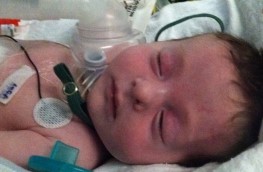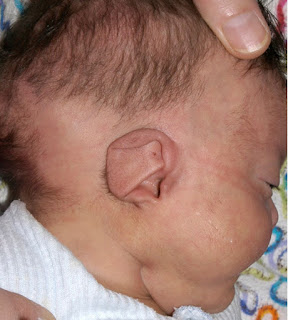Anesthetic Management of Pt. with CHARGE Syndrome
Definition:
➧ A syndrome characterized by:
1-Coloboma of the eye (Figure 1)
2-Heart defects (ASD, VSD, PDA, TOF, Rt. Aortic arch, Double outlet Rt. ventricle)
3-Atresia of the choanae (Figure 2)
4-Retarded growth development and/or central nervous system abnormalities
Severe sensorineural, visual, and vestibular deficits are suggested as the cause of delay in walking development, rather than retardation.
5-Genital hypoplasia in males (Hypogonadism)
6-Ear anomalies (Figure 3) and/or deafness (Figure 4)
➧ Diagnosis is made on the presence of at least four of the criteria.
 |
| Figure 1: Coloboma of iris |
 |
| Figure 2: Atresia of the choanae |
 |
| Figure 3: Ear anomalies |
 |
| Figure 4: Deafness (BAHA) |
➧ Other abnormalities include:
Muscular hypotonia, facial palsy, tracheo-oesophageal fistula, cleft lip and palate, micrognathia, laryngomalacia, pharyngolaryngeal hypotonia (inability to maintain the patency of the pharyngolaryngeal passage), subglottic stenosis and other upper airway abnormalities.
➧ There is a high incidence of abnormal blood gas levels and sleep problems. Cardio-respiratory arrest is common in this group of patients.
➧ Gastroesophageal reflux has been reported.
➧ Anesthesia may be required for choanal atresia repair, cardiac surgery, tracheoesophageal fistula, ear surgery, Nissen’s fundoplication, and tracheostomy.
Anesthetic Management:
Preoperative Management:
1. Preoperative assessment of congenital cardiac defects.
2. Preoperative assessment of upper airway abnormalities. Pharyngo-laryngeal hypotonia causes variable obstruction, which becomes more pronounced during sleep and during inspiration.
3. Precautions against aspiration of gastric contents.
Intraoperative Management:
1. A range of sizes of endotracheal tubes should be available due to subglottic stenosis.
2. If micrognathia is present, inhalational induction is advisable.
3. Tendency for upper airway collapse during light anesthesia due to laryngomalacia or pharyngolaryngeal hypotonia. Edematous arytenoids may result from gastroesophageal reflux.
4. Tracheal intubation difficulties have been recorded and intubation problems are increased with increasing age.
5. Tracheostomy may be required for long-term management. Some authors felt that early tracheostomy helped to avoid hypoxemic events in infancy.
Postoperative Management:
1. Postoperative monitoring of apnea.
2. Feeding difficulties and a high incidence of gastroesophageal reflux.
Postoperative Mortality:
1. Apnea due to pharyngolaryngeal hypotonia.
2. Postoperative deaths were frequently associated with pulmonary aspiration.
3. Patients require multiple anesthetics, with an increased incidence of postoperative mortality.


























